Compiled by/Jun Lin
With governments of all countries paying more attention to climate issues and people's increasing awareness of environmental protection, it seems that technology companies in Silicon Valley have also found another driving force besides car building - clean technology.
Martin Rohsen was once a pioneer in the solar energy industry, leading a Google Startups invested by founders. The company aims to use solar energy, which is cheaper than fossil fuel energy, to start a green revolution.
The Austrian entrepreneur once studied computer science at Stanford University, and was classmates with Google founders Larry Page and Sergey Brin. After graduation, Rosison also witnessed the prosperity of the Internet and the bursting of the Internet bubble. Rosison believes that green energy will become the next revolution and create wealth for Silicon Valley investors.
He said: "More and more venture capitalists have listed clean technology separately and started to pour money into this field. Clean technology has become very competitive."
However, although solar energy is becoming the cheapest form of energy in the world, Silicon Valley has missed it. On the contrary, with the support of Beijing, China's solar panel production has grown rapidly, and the cost of solar energy has decreased by as much as 80% in the past decade. Rosison's start-up company has developed a product that can replace solar silicon panels. But his company went bankrupt in 2013. Today, he runs a company that produces artificial diamonds.
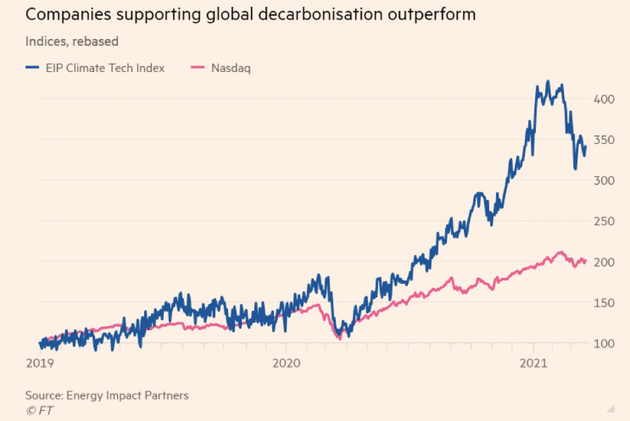 Figure: Companies supporting global decarbonization performed well
Figure: Companies supporting global decarbonization performed well Rosison participated in the first wave of clean energy entrepreneurship, but most of the entrepreneurial companies in this wave failed to develop successfully. At the same time, after the financial crisis, Beijing vigorously supported the country's solar, wind and battery companies in capital, land and other aspects. According to PricewaterhouseCoopers data, between 2006 and 2011, venture capitalists invested 25 billion US dollars in the field of clean technology, half of which was lost, forcing them to transfer their funds to development companies related to applications, software and artificial intelligence. These areas can grow rapidly without a lot of capital.
However, China's success in developing solar energy and reducing the cost of wind energy and electric vehicle batteries has laid the foundation for a new wave of investment in clean energy start-ups, which can also be called the "clean technology 2.0 era".
From new battery storage technology to sustainable aviation fuel, artificial meat and low-carbon concrete, investors are scrambling to catch up with renewable energy producers and other companies dealing with climate change to send money to them.
In the past year. Dozens of companies have raised billions of dollars by listing on the American Stock Exchange through mergers with Special Purpose Acquisition Companies (SPACs). QuantumScape, a San Jose based battery startup, went public last year and is now worth $21 billion. according to Bank of America The total market capitalization of these listed companies, which are intended to benefit from the transformation of fossil fuels, is about US $6 trillion.
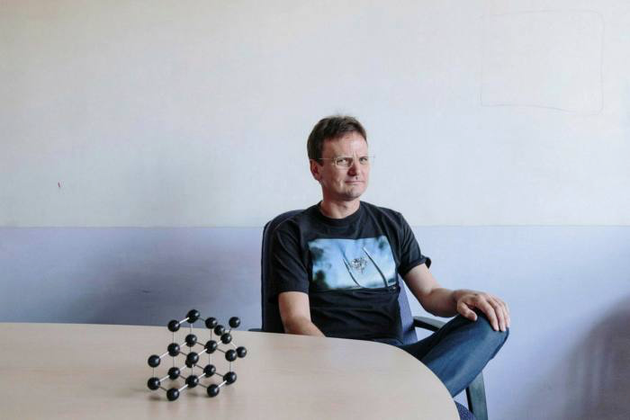 Picture: Martin Roscheisen
Picture: Martin Roscheisen However, it is extremely difficult and may take several years to develop laboratory technology into low-cost, mass market products with the potential to reduce global carbon emissions. Many investors have received this fact at a painful price in the past decade.
But now the situation has changed. Sophie Putom, an investor, said: "Climate change is affecting everything around us, so many companies are no longer immersed in a single area. Now, we can feel the impact of climate change directly, enterprises are affected, and the economy is also affected. In the past, climate change may have been just data and graphs, but now it has become a real time bomb. "
Large technology companies around the world have also fully recognized the seriousness of the climate crisis. Therefore, they also took certain measures.
In September 2019, Amazon More than 25000 products labeled "Climate Friendly Commitment" were put on the shelves, including groceries, household products, beauty and fashion products, and personal electronic products. In addition, Amazon proposed to achieve the goal of 100% use of renewable energy in daily operations by 2025.
Another technology giant Apple The company is not behind. At the autumn press conference in 2020, Apple announced the cancellation of the earphones and plugs attached to the iPhone, saying that it would reduce 2 million tons of carbon emissions annually for production and logistics
On April 1, Beijing time, Apple announced that at present, more than 110 manufacturing partners worldwide have committed to using 100% renewable energy in the production of Apple products, including nearly 8GW of planned clean energy. On the same day, CEO Tim Cook also released micro-blog He said that Apple has reached and exceeded the goal of 2 gigawatts of clean energy production in China.
In addition, Google said that it will achieve global real-time zero carbon operation in 2030, and will transition the statistical range of zero carbon from year to hour. Microsoft It is also said that negative carbon emissions will be achieved by 2030, and all historical carbon emissions of enterprises will be eliminated by 2050.
In China, in 2019, Baidu The three super large cloud computing data centers built in the hinterland of North China save more than 100 million kilowatt hours per 100000 servers annually. In addition, through emission reduction of office buildings, charging piles and data centers, Baidu's carbon reduction in 2019 reached 187018 tons.
In January this year, tencent Ma Huateng, the founder and CEO of the company, also said in the circle of friends when announcing the launch of the carbon neutral plan: "It is expected that the largest proportion in the future will be the realization of the data center supported by primary clean energy. It is difficult, but we should always work hard."
On March 12, Ant Group launched the latest scheme of carbon neutrality in 2021. The scheme plans to achieve carbon neutrality in operational emissions by 2021 and net zero emissions by 2030.
In addition, the governments of China and the European Union have also committed to achieving the goal of zero greenhouse gas emissions by the middle of this century, which has also laid a market foundation for clean technology products.
In September 2020, China promised to reach its carbon peak by 2030, and said that the proportion of carbon dioxide emissions in GDP in that year would drop by more than 65% compared with 2005, and by 2060, China would achieve net zero carbon emissions, that is, carbon neutrality. In addition, in the government work report of this year's two sessions, "carbon peaking and carbon neutrality" was also listed as one of the key tasks in 2021.
On March 31 local time, US President Joe Biden announced a $2 trillion infrastructure plan. The eight year plan focuses on rebuilding the aging infrastructure of the United States and promoting the development of electric vehicles and clean energy.
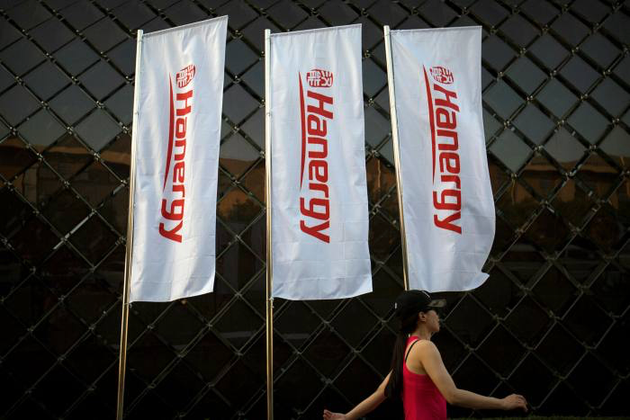 Figure: China Hanergy
Figure: China Hanergy Learn from mistakes
In a TED speech in 2007, John Dole, a partner of Silicon Valley venture capital firm Cappen Huaying, said: "Green technology - going green - is more important than the Internet. It will be the biggest economic opportunity in the twenty-first century."
Capvision Huaying and other venture capital companies began to invest millions of dollars in solar start-ups and battery manufacturers (such as A123 Systems). A123 Systems was listed in 2009, when its market value once exceeded $1.9 billion. Solyndra in California, aiming to produce solar panels without silicon materials, raised nearly $1 billion and obtained a loan of $535 million from the US government.
Vinod Khosla, a billionaire investor in Silicon Valley, said in 2008: "The solar energy field is booming in Silicon Valley."
However, the surge in Chinese production has changed the situation. The global price of polysilicon (the raw material for solar cells) has dropped rapidly, and the market demand for innovative technologies invested by American venture capital companies has also disappeared. By 2015, most of the solar panels used in the world will be made in China.
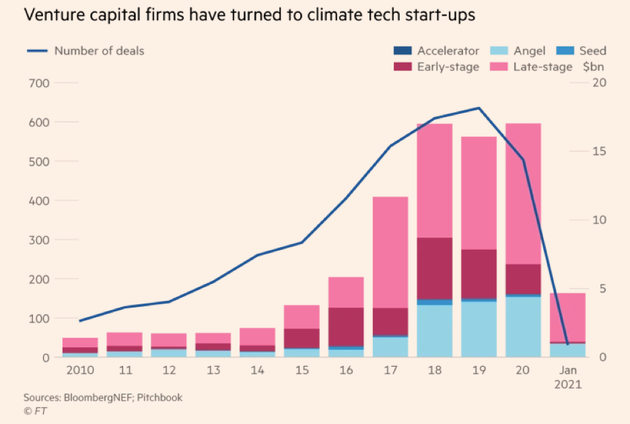 Figure: The trend of venture capital towards climate technology start-ups
Figure: The trend of venture capital towards climate technology start-ups These start-ups invested by Silicon Valley were almost completely destroyed. In 2013, Chinese solar energy company Hanergy acquired the promising solar energy startup MiaSol é, a company invested by Kaplan Huaying in 2013. In the field of batteries, Wanxiang Group, a Chinese auto parts manufacturer, acquired A123 Systems for US $257 million. Rob Dy, partner of Spring Lane Capital, a Boston venture capital firm, said, "This is the boom and decline caused by the excessive influx of venture capital."
In 2010, after he was forced to leave his company, Rosison bought a one-way ticket to China to study the reasons for China's success in the field of clean energy technology. Today, he believes that the "planned moon landing" strategy of Silicon Valley is the root cause of failure. Silicon Valley only values major breakthroughs, but little attention is paid to the stable improvement of clean energy technology by increasing production.
But early failures did not stop the world's richest investors from moving forward. In 2015, Bill Gates decided to turn the tide of venture capital. That year, when world leaders gathered to attend the Paris Climate Summit, Bill Gates gave other billionaire friends (such as Amazon founder Jeff Bezos, Virgin Galactic Founder Richard Branson et al.) sent an email proposing to establish the "Breakthrough Energy" alliance to invest in clean energy technology.
Since then, two venture capital funds under Energy Breakthrough have raised more than $2 billion and plan to invest in dozens of clean technology start-ups involving technologies from green hydrogen energy to nuclear fusion energy, with the goal of helping the world achieve net zero emissions by 2050. Silicon Valley celebrities, such as Khosla and Dole, are the chairman of the board of directors of the Alliance.
Carmichael Roberts, the founding partner of Energy Breakthrough's fund, has previously participated in venture capital investment in start-ups such as A123 Systems. He said that the fund learned from past failures, formulated strict investment standards, and also planned a long-term investment prospect of up to 20 years. The fund only invests in start-ups with the potential to reduce 500 million tons of greenhouse gases from the atmosphere every year. 500 million tons of greenhouse gases, accounting for about 1% of global emissions.
"The entrepreneurial enthusiasm in this field is now unprecedentedly high." Roberts said, "Looking back to the clean technology 1.0 era, there are only a few companies in this industry. But now, the current trend is the revival of the business in those years."
Technical risk
Roberts believes that in the clean technology 1.0 era, many start-ups failed not because of technical problems, but because of the lack of financing options. Today, they have more funding options, including SPAC. For example, yesterday, it was reported that Impossible Foods, an artificial meat company, planned to enter the capital market with a valuation of at least $10 billion. Insiders said that Impossible Foods planned to go public in the next 12 months through IPO or merger with special purpose acquisition companies (SPACs). In addition, a series of venture capital companies and large industrial companies also have their own venture capital departments
Roberts said: "We are seeing more and more ways of cooperation. We have learned a lot of lessons, and investors are more sensible than before."
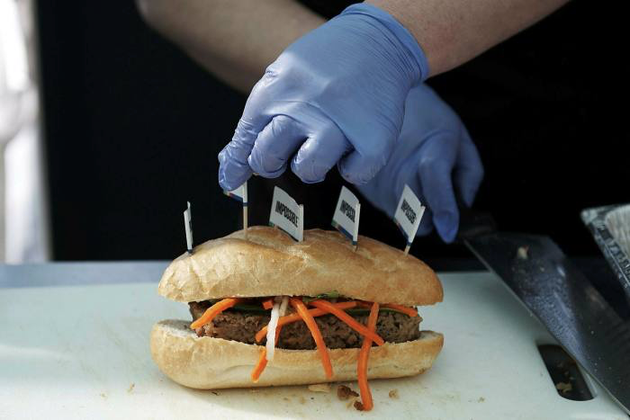 Figure: Investors are investing heavily in projects promoting decarbonization, such as artificial meat, sustainable aviation fuel and low-carbon concrete.
Figure: Investors are investing heavily in projects promoting decarbonization, such as artificial meat, sustainable aviation fuel and low-carbon concrete. Khosla still insists on investing in the field of clean technology, although when China rose in the market that year, several solar energy companies he invested in were on the verge of bankruptcy. Khosla said that many start-ups developed in the first wave of clean technology did succeed, such as Elon Musk's electric car company Tesla 。 Tesla not only survived, but also provided an example for other entrepreneurs.
Kosla said, "I don't think that Clean Technology 1.0 is a failure. It is a common venture capital model. You have invested in hundreds of companies, but often only one can bring a thousand times return."
Khosla believes that these technologies can breed products like Google, Apple and Facebook These large companies have become active investors in clean energy. However, he said that the difficulty in this field lies in the long development cycle, which is very similar to the difficulty in drug development. However, there is a lack of a large mature market in the field of clean technology, and no mature enterprise is willing to acquire a startup company with unproven technology, such as low-carbon cement and alternative jet fuel.
"Traditional oil and gas companies will also tend to block the development of these new technologies. They will not join the ranks of new technologies and say, 'Let us lead the times together.'" Kosla said, "They block because they are afraid. They are willing to invest in solar power plants, just because solar and wind power plants are no longer risky, they will not take any risks. "
But Gates and Khosla have also suffered setbacks in the field of clean technology recently. Aquion Energy, a startup company they invested in, aimed to develop non-toxic and environmentally friendly brine batteries. It went bankrupt in 2017 and was later acquired by a Chinese company. LightSail Energy, another air storage startup invested by Khosla, also declared bankruptcy in the same year.
Roberts said: "Even if we fail, we should also face the risk of cutting-edge technology bravely. I would not say that the risk of failure will be significantly reduced in the era of clean technology 2.0... We still face huge technical risks, which may be greater than the risk of the previous era, but the risk of the whole system is reducing."
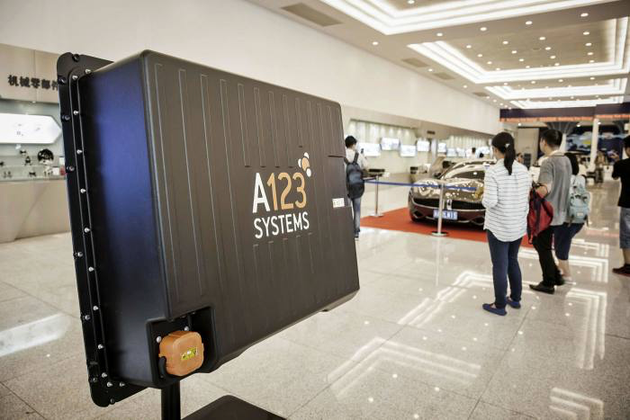 Figure: A123 Systems
Figure: A123 Systems One way transition
Recently, the increasingly popular SPAC has provided a new way for venture capitalists to withdraw from their investment projects, and also brought new capital options for companies that want to increase their financing scale to expand production. In the past year, 40 climate related companies went public through merger with SPAC, including QuantumScape, an electric vehicle battery startup invested by Energy Breakthrough Fund and Kosra.
Even so, after the rapid rise of the share price of clean technology stocks, analysts have begun to alert the market to the impending collapse. If the losses expand, it may once again prevent investors from entering the field. According to the index compiled by clean technology investor Energy Impact Partners, the share price of clean energy technology companies has risen 137% so far this year, while NASDAQ The composite index rose only 48%.
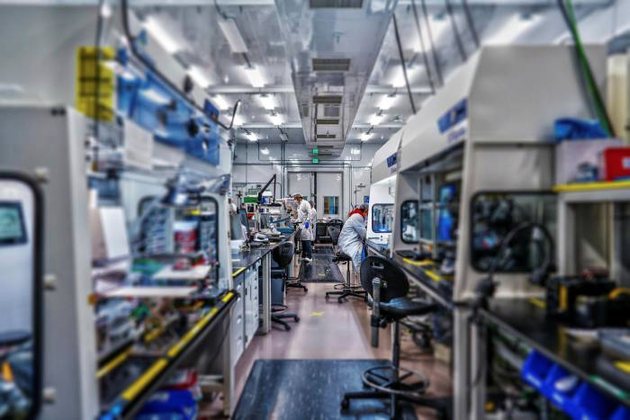 Figure: QuantumScape
Figure: QuantumScape Khosla has applied for the establishment of four special purpose acquisition companies last month to seek acquisitions. He said: "If all this once again evolves into a financial frenzy rather than truly enabling a clean energy economy worth billions of dollars, we may suffer a heavy blow."
Dai of Spring Lane said, "I see that the book value of many companies is absurdly high. When I see this phenomenon, I can't help thinking that the law of gravity is still valid, and these companies will return to the foundation sooner or later."
Andrew Bieber, executive director of Obvious Ventures in San Francisco, believes that the urgent need to avoid the worst impact of climate change means that the field of clean technology can no longer withstand investors' giving up again.
Bieber worked for Suntech, a solar energy company. In 2013, Suntech's manufacturing department declared bankruptcy. Bieber said, "I don't believe that one day when we look back on the past, we can say, 'Look, clean technology 2.0 won't work'. This day will not come. The current transition, our journey, is one-way. We can't go back to the era of gasoline cars, nor can we go back to the era of thermal power plants; If we had a choice, we would not go back to the days when the air was dirty and the living conditions were unhealthy. The lesson of the past decade is that we have choices in almost every field. "





























